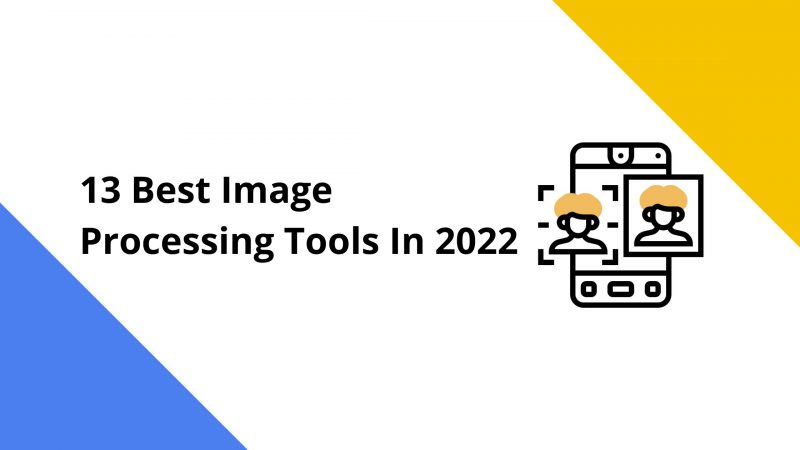Over the past few years, there has been a significant increase in computer vision tools.
Although the acceptance of computer vision has been steadily increasing over the past 10 years, there has recently been a surge in the use of various computer vision technologies due to its applications in the Internet of Things (IoT), manufacturing, healthcare services, security, and other industries.
The technology behind computer vision devices has developed over time to the point that it is now available as a service. Computer vision is much more spectacular today thanks to technological advancements like GPUs, machine learning tools, and systems. Major cloud service providers like Google, Microsoft, and AWS have all jumped into the competition to win over developers. But which tool would it be wise for you to choose? Let us assist you with the 13 best image processing tools!
The discussion of this article is solely about the 13 best image processing tools that would help you create wonders in your business. A Computer Vision Services Company provides services and products with a focus on helping you turn unstructured image and video data into valuable information.
What exactly is image processing?
Image processing, as the name implies, is the process of processing an image, which may involve a variety of ways till we achieve our aim.
The final result can be either an image or a comparable feature of that image. This information can be used for additional analysis and decision-making.

But what exactly is an image?
A 2D function F(x,y) can represent an image, where x and y are spatial coordinates. The intensity of a picture is defined as the amplitude of F at a given value of x, y. We refer to it as a digital image if the values of x, y, and amplitude are finite. It is an array of pixels set up in rows and columns. Pixels are the components of an image that hold data about color and intensity. An image can also be represented in 3D, where x, y, and z are spatial coordinates. A matrix-like arrangement of pixels has been created. An RGB image is what this is.
Now that you know what image processing is, assuming you don’t know, let’s learn about the 13 best image processing tools!
The 13 Best Image Processing Tools To Look Forward To in 2023
- OpenCV
Multi-platform is a widely used library that is easy to use. It works beautifully with C++ and Python and covers all the key techniques and algorithms to carry out a few image and video processing jobs.
- Matlab
Matlab is a fantastic tool for developing image processing programs and is frequently used in research since it enables rapid prototyping. Another noteworthy angle is that Matlab code is far shorter than C++ code, making it easier to read and troubleshoot. It handles mistakes before execution by making several suggestions to speed up the function.
- CUDA
The foundation for parallel computing is provided by NVIDIA, which is simple to program, highly efficient, and speedy. By making use of GPU power, it offers fantastic performance. The NVIDIA Performance Primitives library, which includes a selection of image, signal, and video processing operations, is incorporated into its toolbox.
- Tensorflow
This one is the most popular machine learning and deep learning library available today. Because of the API’s simplicity, it gained popularity rapidly and outperformed other libraries. TensorFlow is a free, open-source library for differential programming and data streams. It is a symbolic math library used for machine learning applications like neural networks.
TensorFlow 2.0 promotes pre-built models geared at object detection, reinforcement learning, speech and image recognition, and other tasks. Such reference models enable you to use particular best practices and serve as a starting point for developing your elite solutions.
- SimpleCV
A system for creating computer vision applications is called SimpleCV. It provides access to several computer vision technologies on any kind of OpenCV, pygame, and other platforms. This is the tool you need if you don’t want to learn the ins and outs of image processing and just need to get the job done. SimpleCV is the finest option if you need to perform some quick prototyping.
- PyTorch
PyTorch platform for open-source machine learning. It is intended to shorten the time it takes to get from a research prototype to commercial development.
- A simple changeover to production
- Adaptive distributed learning and performance improvement
- Thriving tool and library ecosystem
- Excellent support for the main cloud platforms
- Modules for autonomous differentiation and optimization
- Keras
A deep learning Python library called Keras integrates components from several other libraries, such as Tensorflow, Theano, and CNTK. Because Keras is built on top of Tensorflow, it has an advantage over rivals like Scikit-learn and PyTorch.
TensorFlow, Microsoft Cognitive Toolkit, Theano, or PlaidML can all be used with Keras. It focuses on convenience, quantifiable quality, and extensibility and is designed for rapid experiments with deep neural networks. Best practices for reducing cognitive burden are followed by Keras, which provides stable and basic APIs and restricts the amount of user interaction needed for typical use cases.
- Theano
A rapid Python numerical library that may be used with a CPU or GPU is called Theano. It was developed by the LISA group, now known as MILA, at the Canadian University of Montreal. Theano is an improving compiler for managing and evaluating mathematical expressions, particularly those using matrix values.
- EmguCV
EmguCV is a cross platforms Image processing .Net add-on for OpenCV. It works with languages that are.NET compatible, such as IronPython, C#, VB, and VC++.
It is compatible with Windows, Linux, Mac OS, iOS, and Android. It is also compatible with Unity, Xamarin Studio, and Visual Studio.
- GPUImage
It is a framework built on OpenGL ES 2.0 that enables GPU-accelerated effects and channels to be added to the live-act video side, still images, and motion pictures. A lot of code must be written to set up and maintain running custom channels on a GPU.
- YOLO
A method for object detection called “You Just Look Once” (YOLO) was designed specifically for real-time processing. The University of Washington researchers Joseph Redmon and Ali Farhadi developed YOLO, a sophisticated real-time object detecting system. Their technique applies a neural network to the entire image, dividing it into a grid and leaving imprints of the districts with the discovered objects.
- VXL
VXL is a group of free C++ libraries. The functionalities of this image processing tool are
- Open, save and edit photos in various widely used file types, including large images.
- Geometry in 1, 2, or 3 dimensions for points, curves, and other basic objects
- Camera physics
- Reestablishing stability after movement
- Creating a visual user interface
- 3D topology pictures
- BoofCV
BoofCv is an Apache 2.0 licensed open-source Java framework for real-time robotics and computer vision applications that can be used for commercial and academic purposes. Its capabilities include camera alignment, structure-from-motion, feature tracking, and optimized low-level image processing algorithms.
Conclusion
The world is altering as a result of deep learning’s use of Broadway terminology and innovations in the area of image processing. The learning does not end here because researchers are developing better methods to fine-tune the entire image processing area.
Several image processing processes can be used to carry out all the tasks you need to perform. Utilize the information we have shared as 13 Best Image Processing Tools.
Otherwise, no matter how many or what kind of image processing demands you have, Folio3 has a solution for you. Our experts would be delighted to be your AI Image Processing Service anytime.










